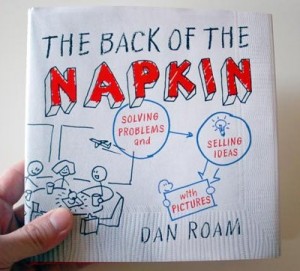The Back of the Napkin: Solving Problems and Selling Ideas with Pictures, written by Dan Roam, is a bold effort at introducing business people to using visual thinking principles to solve problems and communicate more effectively. Visual thinking is something that I feel I excel at; however, I know it has been a challenge for many of my co-workers, managers, and clients. Even if you don’t struggle with visual thinking, I recommend The Back of the Napkin (four of five stars) as it provides a valuable set of processes and frameworks that can even benefit experienced visual thinkers, who probably operate more by intuition than methodology.
Highlights from The Back of the Napkin
Roam breaks down visual thinking into a four-step process: look, see, imagine, and show. He makes the important point that visual thinking isn’t about just drawing. In fact, drawing is actually the last step after looking, seeing, and imagining – things that anyone can do and require no artistic or graphic design skills.
Although it is a rather awkward acronym, SQVID is a valuable framework for bringing an idea to visual clarity and for refining its focus through a series of question pairs (simple-elaborate, qualitative-quantitative, vision-execution, individual-comparison, change-status quo). In the first pair of simple-elaborate, I liked how Roam identified that the opposite of simple is not complex, but rather elaborate. Many presentation experts demand simplification but as Roam states the goal of visual thinking is “to make the complex understandable by making it visible – not by making it simple.”
Another awkward but useful framework is Roam’s <6><6> model for choosing appropriate visuals (e.g., chart, map, timeline, multiple-variable plot, etc.). Nothing is more frustrating to a PowerPoint ninja than seeing a presenter using the wrong type of visual in a presentation. Using the <6><6> model, you can verify that you’re using the most effective visual based on the type of information you’re trying to show.
Criticisms of The Back of the Napkin
As I’ve already pointed out, Roam uses clunky acronyms for his frameworks and processes, which makes them memorable for the wrong reason. As some other reviewers have noted, nearly a third of the book is devoted to a fictional case study, where he demonstrates all of his visual thinking models and frameworks. Although it is a valuable and necessary process that shows how to apply his ideas, I wish he could have condensed it and spent more time on further developing his concepts with more real-world examples, which were really insightful when he shared them.
How does this book apply to PowerPoint presentations?
Pictures (e.g., charts, diagrams, etc.) are important to creating effective business presentations. I strongly agree with Roam that the simplicity and immediacy of pictures can help us to discover and clarify our own ideas as well as help other people to understand our ideas. Although Roam mainly advocates a pen and paper or a whiteboard approach over using presentation software, many of his techniques and frameworks can still be applied to creating more effective PowerPoint visuals. Even if you’re building diagrams for a PowerPoint presentation, it may be a good idea to sketch out a problem or idea before you even touch the software. In relation to the common phrase “a picture is worth a thousand words”, I liked Roam’s emphasis that we don’t need to replace all of the words in our business presentations. We use pictures to replace “those words that are more effectively conveyed, understood, and remembered visually“.



June 2nd, 2010 10:55 pm
[…] Brent Dykes, PowerPoint Ninja: Even if you don’t struggle with visual thinking, I recommend The Back of the Napkin (four of five stars) as it provides a valuable set of processes and frameworks that can even benefit experienced visual thinkers, who probably operate more by intuition than methodology. […]